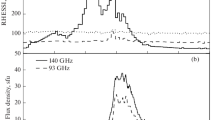Abstract—
The temporal evolution of thermal bremsstrahlung in the sub-terahertz range is calculated for F-CHROMA models of the flare chromosphere and transition region (https://www.fchroma.org). These models are calculated based on the numerical solution of the system of equations of radiation hydrodynamics with the RADYN code, which describes the response of chromospheric plasma to the flux of accelerated electrons in the form of a triangular pulse. It is found that the positive slope of the spectrum in the frequency range of 93–400 GHz is formed during the entire burst. The sub-THz radiation peak can be both ahead and behind the maximum of the function of the injection of energetic electrons depending on the number and index of the spectrum of precipitating particles. In some cases, the time profile of the sub-THz radiation is quite complex and pulsating due to gas-dynamic phenomena in the chromosphere and transition region.









Similar content being viewed by others
Change history
29 December 2021
An Erratum to this paper has been published: https://doi.org/10.1134/S0016793221070288
REFERENCES
Allred, J.C., Hawley, S.L., Abbett, W.P., and Carlsson, M., Radiative hydrodynamic models of the optical and ultraviolet emission from solar flares, Astrophys. J., 2005, vol. 630, pp. 573–586.
Allred, J.C., Kowalski, A.F., and Carlsson, M., A unified computational model for solar and stellar flares, Astrophys. J., 2015, vol. 809, id 104.
Carlsson, M. and Stein, R.F., Non-LTE radiating acoustic shocks and CA II K2V bright points, Astrophys. J., 1992, vol. 397, pp. L59–L62.
Carlsson, M. and Stein, R.F., Formation of solar calcium H and K bright grains, Astrophys. J., 1997, vol. 481, pp. 500–514.
Dulk, G.A., Radio emission from the Sun and stars, Annu. Rev. Astron. Astrophys., 1985, vol. 23, pp. 169–224.
Kašparová, J., Heinzel, P., Karlický, M., et al., Far-IR and radio thermal continua in solar flares, Cent. Eur. Astrophys. Bull., 2009, vol. 33, pp. 309–317.
Kašparová, J., Carlsson, M., Heinzel, P., and Varady, M., Modelling of flare processes: A comparison of the two RHD codes FLARIX and RADYN, ASP Conf. Ser., 2019, vol. 519, pp. 141–146.
Kontar, E.P., Motorina, G.G., Jeffrey, N.L.S., et al., Frequency rising sub-THz emission from solar flare ribbons, Astron. Astrophys., 2018, vol. 620, id A95.
Kostiuk, N.D. and Pikelner, S.B., Gasdynamics of a flare region heated by a stream of high-velocity electrons, Sov. Astron., 1975, vol. 18, pp. 590–599.
Krucker, S., Giménez de Castro, C.G., Hudson, H.S., et al., Solar flares at submillimeter wavelengths, Astron. Astrophys. Rev., 2013, vol. 21, no. 1, id 58.
Livshits, M.A., Badalyan, O.G., Kosovichev, A.G., et al., The optical continuum of solar and stellar flares, Sol. Phys., 1981, vol. 73, no. 2, pp. 269–288.
Machado, M.E., Avrett, E.H., Vernazza, J.E., and Noyes, R.W., Semiempirical models of chromospheric flare regions, Astrophys. J., 1980, vol. 242, no. 15, pp. 336–351.
Morgachev, A.S., Tsap, Yu.T., Smirnova, V.V., and Motorina, G.G., Simulation of subterahertz emission from the April 2, 2017 solar flare based on the multiwavelength observations, Geomagn. Aeron. (Engl. Transl.), 2018, vol. 58, no. 8, pp. 1113–1122.
Morgachev, A.S., Tsap, Yu.T., Smirnova, V.V., and Motorina, G.G., On the source of subterahertz radiation of the solar flare on April 2, 2017, Geomagn. Aeron. (Engl. Transl.), 2019, vol. 59, no. 8, pp. 1114–1120.
Ruan, W., Xia, C., and Keppens, R., Extreme-ultraviolet and X-ray emission of turbulent solar flare loops, Astrophys. J., 2019, vol. 877, id L11.
Silva, J.F.V., Giménez de Castro, C.G., Simões, P.J.A., and Raulin, J.-P., Submillimeter radiation as the thermal component of the Neupert effect, Sol. Phys., 2019, vol. 294, no. 11, id 150.
Tsap, Yu.T., Smirnova, V.V., Morgachev, A.S., et al., On the origin of 140 GHz emission from the 4 July 2012 solar flare, Adv. Space Res., 2016, vol. 57, no. 7, pp. 1449–1455.
Varady, M., Kasparova, J., Moravec, Z., et al., Modeling of solar flare plasma and its radiation, IEEE Trans. Plasma Sci., 2010, vol. 38, no. 9, pp. 2249–2253.
Vernazza, J.E., Avrett, E., and Loeser, R., Structure of the solar chromosphere. III. Models of the EUV brightness components of the quiet Sun, Astrophys. J. Suppl. Ser., 1981, vol. 45, pp. 635–725.
Funding
This study was supported in part by the Russian Foundation for Basic Research, project no. 18-02-00856-a; Ministry of Science and Higher Education of the Russian Federation, project no. 0831-2019-0006; Ministry of Science and Higher Education of the Russian Federation, project no. RFMEFI62020X0003 and project nos. RVO:67985815 and LM2015067: EU-ARC.CZ.
Author information
Authors and Affiliations
Corresponding author
Ethics declarations
The authors declare that they have no conflict of interest.
Additional information
Translated by O. Pismenov
Rights and permissions
About this article
Cite this article
Morgachev, A.S., Tsap, Y.T., Smirnova, V.V. et al. Numerical Simulation of Sub-Terahertz Thermal Emission: RADYN Code. Geomagn. Aeron. 60, 1038–1049 (2020). https://doi.org/10.1134/S0016793220080174
Received:
Revised:
Accepted:
Published:
Issue Date:
DOI: https://doi.org/10.1134/S0016793220080174




